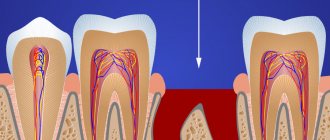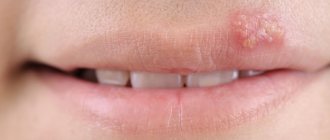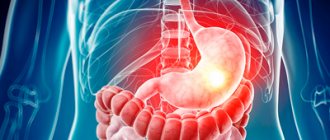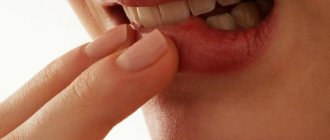The anatomical structure of the human body has a very complex arrangement of organs and systems. For a detailed study, each part must be considered separately. The structure of the cheek consists of muscle fibers, which are covered with mucous membrane on the inside of the oral cavity, and skin on the other. In turn, between the skin and the muscle layer, some people have a fairly thick layer of fat. It is classified as the buccal fat pad, which is very well developed in childhood and is also present in the adult population.
Causes of swelling on the cheek
Many people believe that only teeth can provoke swelling of the cheeks. In fact, the reasons may be different.
Dental diseases
Factors related to oral health can provoke the problem. Among them:
- Eruption of impacted wisdom teeth, especially if the patient is over 25 years old. If the growth is abnormal, it is recommended to remove the “eight”.
- Stomatitis affecting the cheek, gums, tongue. The disease is most often diagnosed in children, but it can also occur in adults. An advanced disease provokes swelling. The cheek hurts from the inside, in the corner of the mouth.
- Gum disease, in which pathogenic bacteria accumulate in dental plaque, causing inflammation. Thus, gingivitis is accompanied by bleeding gums, swelling, and bad breath. If the disease is neglected, it will develop into periodontitis, a more serious problem.
Complications in the form of swelling of the cheek can develop after endodontic treatment. If during the procedure the canals are not washed and cleaned well enough, inflammation develops in the pulp chamber. The pathogenic process spreads to the bone, gum and cheek. This is how purulent periostitis develops, which is popularly called “flux”. If the disease is not treated in time, phlegmon and sepsis may develop, which pose a health hazard.
During the recovery period after tooth extraction, swelling of the cheek may also be observed. More often the symptom appears if the intervention was performed on the lower jaw. This problem often arises after implantation. This is the body's reaction to traumatic actions. It goes away in a few days. Otherwise, you need to consult a dentist, who must confirm or rule out the presence of a complication. It can develop due to infection getting into the wound, which threatens the manifestation of peri-implantitis.
Infectious, colds and other diseases
Cheek swelling is one of the symptoms of such diseases:
- Parotitis. When the disease occurs, the salivary glands become inflamed, which explains why soft tissues swell.
- Lymphadenitis. It occurs as an independent disease or as a complication of other ailments, such as diseases of the ENT organs. With lymphadenitis, the cervical, parotid and submandibular lymph nodes become enlarged, and the cheek becomes inflamed.
- Otitis, sinusitis, sinusitis. The inflammatory process can spread to the cheek, under the eye, and the area near the nose.
Pathological processes in gingival tissues often provoke inflammation of the salivary ducts and glands. It can also be an independent disease. It is caused by stones in the ducts, cysts, tumors.
The mucous membrane also swells with inflammation of the trigeminal nerve. In this case, other symptoms appear: numbness, pain radiating to the ear, “lumbago”. Swelling is a common occurrence in diseases of internal organs. Excess fluid due to malfunction of one or another organ accumulates in soft tissues, including the facial area.
Other causative factors
Swelling can also appear as a result of injury. This symptom accompanies soft tissue bruises, joint dislocations, and jaw fractures, which can be caused by a blow or fall. Children are more often susceptible to injury due to their excessive physical activity. Swelling can occur due to an allergic reaction, when the body shows immunity to a certain product. Other reasons:
- severe burn (both thermal and chemical);
- insect bites, which also cause redness and induration;
- poor oral hygiene.
Cheek swelling can occur in pregnant women. The fact is that during this period hormonal changes occur in the body. As a result, the gums swell, which is reflected on the cheek.
The structure of the oral cavity and the functions of its structures
The mouth, or oral cavity, is made up of many structures that work together to help us breathe, speak, smile, eat, and digest food. Once you become familiar with these anatomical structures and how they affect your overall health, you will understand why proper and regular oral care is so important. Listed below are the elements that make up the human oral cavity and the functions they perform.
Lips and cheeks
The basis of the lips and cheeks are muscles that allow us not only to kiss, but also to express a lot of different emotions - from joy to sadness. Through open lips, air enters the mouth and then into the lungs, allowing us to breathe. The muscles of the lips and cheeks help us speak. In addition, while eating, they retain food and saliva in the mouth. Finally, these strong muscles also influence the position of our teeth.
Language
The tongue is a powerful muscle that helps us chew, swallow, speak and taste food. Thanks to the taste buds, or taste receptors, located in the tongue (as defined in the Atlas of Human Anatomy), we can enjoy the taste of food. In total, in the oral cavity - on the tongue, palate, mucous membrane of the pharynx - there are up to 2500 such receptors, with the help of which we distinguish sweet from salty, bitter from sour.
Teeth, gums and alveolar bone
Teeth have a crown covered with hard enamel and roots that are held in the jaw bone. The stability of the teeth is ensured by the alveolar bone, periodontal ligament and gums surrounding the roots, which also protects the roots of the tooth from caries. The main function of teeth is to crush and grind food so that it can be digested in the stomach. In addition, teeth support the soft tissues of the face, giving them a certain shape, help us pronounce certain sounds and make our smile attractive.
Salivary glands
Humans have six glands that produce a clear liquid called saliva. Saliva is mostly water, but also contains substances that break down food so it can be digested. In addition, saliva moistens the mouth, making it easier to speak, chew and swallow. It continually washes away bacteria from your teeth and gums, helping prevent the development of tooth decay and periodontitis. The minerals and proteins contained in saliva play an important role in protecting the enamel from carious lesions. According to information presented on the MedWeb information portal, the human body produces up to two liters of saliva per day.
Temporomandibular joint
The ability to open and close the mouth, move the lower jaw forward, backward and side to side, as well as chew, speak and swallow, we owe to the work of the temporomandibular joints (TMJ). As dentists explain, these extremely complex paired joints, located on the right and left sides of the face, are set in motion by a whole group of muscles and ligaments. The slightest desynchronization of these joints—for example, due to arthritis or teeth grinding—can cause facial pain, difficulty chewing food, and other jaw mobility problems.
Maintaining oral health
To keep all oral structures healthy, brush your teeth twice daily using fluoride toothpaste, a soft-bristled brush, mouthwash, and clean between your teeth with dental floss. Regular cleaning of the tongue with a special pad on a toothbrush or scraper will help remove plaque accumulated on its surface. Using an antimicrobial mouth rinse will reduce the number of pathogenic bacteria that cause bad breath. It is equally important to give up tobacco and limit the consumption of sugars and other carbohydrates that provoke the development of caries: this will have a beneficial effect on the condition of the body as a whole.
Don't forget to regularly undergo preventive examinations and visit a hygienist for professional teeth cleaning, which allows you to remove tartar and plaque from areas of the dentition that are inaccessible to a brush. By carefully examining the oral cavity, the dentist will also be able to notice in time the slightest signs of cancer, the early diagnosis of which is of paramount importance.
The beauty of teeth is, of course, important, but the good condition and performance of all structures of the oral cavity is even more important, because this is the key to not only dental, but also the general health of each of us.
Symptoms of illness
Depending on the cause, symptoms may vary from case to case. More often with edema, the following symptoms appear:
- swelling on the cheek;
- pain in the causative area;
- difficulties in controlling facial expressions;
- inflammation of the mucous membrane.
It is important to monitor swelling. If it increases, medical attention is required. Reasons to urgently consult a doctor also include increased body temperature, general weakness, purulent discharge from the gums, loss of appetite, numbness and sagging cheeks.
Slime layer
On the inside, the cheeks are covered with a mucous membrane, which can be divided into three parts:
- Superior or maxillary;
- Inferior or mandibular;
- Middle or intermediate (has a position between the first two zones, this area falls on the line where the teeth meet).
The structure of the cheek from the inside in the upper and lower zones has similar layers to the mucous membrane of the lip. The surface of these parts is a thickened keratinized layer of epithelial tissue. It is multi-layered and flat. Small papillae are very rarely located on the mucous plate. Beneath the mucous membrane are the salivary glands. These types of glands are often located immersed in muscle fibers. The largest of all glands are found in the area of the molars and third molars (molars and wisdom teeth).
The intermediate zone has some structural features that differ from the upper and lower areas of the cheeks. The epithelial layer along the line of closure of the teeth turns into a keratinized layer through parakeratosis. The lamina propria of the mucous membrane forms fairly large papillae. There are no salivary glands in this layer of the cheeks. Their place is taken by sebaceous ones. When a child is born, epithelial villi can be seen in the intermediate layer of the newborn from the mucous membrane. Similar villi are observed along the red line of the lips. This feature of the structure of the inside of the cheek, according to doctors, is directly related to the intrauterine fusion of the upper and lower lips at the edges. The muscle mass of this part of the face is formed thanks to the cheek muscle. The layered structure of the cheek includes the following layers:
- leather;
- fat layer;
- muscle layer;
- mucous membrane.
Important! The internal structure consists of several types of muscle tissue. Zygomaticus major muscle, laughter muscle, depressor anguli oris muscle, facial muscles, buccal muscle, buccal-pharyngeal fascia.
Swelling of the cheek on the inside: what to do
How to remove swelling of the cheek? Depending on the degree of manifestation of the unpleasant symptom and the etiology, different treatment methods are used. Their success depends on the correct diagnosis.
When swelling occurs after dental implantation, ice should be applied to the sore cheek. You need to rinse your mouth lightly. It is important to maintain hygiene, diet and spare the postoperative wound.
Drug treatment
The doctor prescribes medications taking into account the clinical picture and the causes of swelling after a comprehensive diagnosis. You may need:
- "Miramistin" and "Chlorhexidine" - for rinsing;
- "Suprastin" is an antihistamine;
- "Nimesil" is an anti-inflammatory drug;
- “Amoxiclav”, “Lincomycin” are antibiotics that are prescribed for acute purulent periostitis.
How to relieve the pain accompanying the causative disease? Hexoral solution or spray or Lidocaine Asept aerosol can help. The painful syndrome in a child is relieved with the help of products that are used during teething, for example, Dentinox.
In some cases, conservative treatment is not enough, so surgical techniques are used. If there is suppuration, the doctor opens the gum, exposes the cavity with pus and installs drainage to drain the exudate. Surgery is also performed in the presence of a neoplasm.
Perioral organ
Inside the human cheek is the perioral or juxtaoral organ of Hivitz. It was first described in 1885, the study was carried out by Zhivitsa, which gave the name to this organ. The perioral organ is an elongated formation of a white cord, which is located inside the buccal temporal fascia. It is also surrounded by soft tissue. In simple words, ORO resembles a nerve. In adults, its length varies from 7 to 17 mm, and its diameter does not exceed 1 to 2 mm. In a small number of people, the perioral organ protrudes into the oral cavity.
Doctors associate the mechanism of appearance of the perioral organ with the process of formation of the parotid gland, or with the characteristic separation of epithelial tissue during intrauterine development, namely the fusion of the maxillary and mandibular processes. There is a capsule around the organ. The stroma of the juxtaoral organ is a dense connective tissue; the parenchyma is formed by strands of epithelial cells, which in turn are surrounded by a thick layer of basement membrane. In some places, epithelial cells form peculiar tubes that are filled with secretions. The general structure is very similar to the gland. The process of keratinization is not observed.
The exact function of the perioral organ has not yet been established. The opinion of scientists and doctors is divided into two groups:
- The first group believes that OPO does not carry a functional load either in the oral cavity or in the human body as a whole. It is only a peculiar outgrowth of the epithelium, which was formed during the fusion of the upper and lower zones of the cheek in the womb. Equated to the fusion of the palatal parts in the suture area;
- the second group is confident that OPO performs two functions, among which are the following factors. The first is part of the neuroendocrine system. The second is mechanoreceptive, due to the presence of numerous nerve endings in the organ, as well as the lamellar corpuscles of Vater-Pacini.
The special location of the perioral organ inside the cheek often causes concern in people who have undergone an x-ray examination. OPC is often confused with well-differentiated squamous cell carcinoma or metastases of a tumor of internal organs. In this case, doctors necessarily prescribe an additional test to detect cancer, and a biopsy is performed.
What not to do if your cheek is swollen
Before removing the swelling, so as not to worsen the situation, you need to understand what can be done and what cannot be done. If you are not sure of the cause of the swelling, you do not need to apply any compresses, neither warm nor cold, before visiting the doctor. Such actions are fraught with negative consequences. For example, when pus forms, a hot compress can accelerate the development of the pathological process. It is not even recommended to sleep on the sore side. You should also not disturb the swollen cheek, press or massage it.
You should not take painkillers immediately before your visit to the doctor. It can obscure the clinical picture and complicate the diagnosis. It is also prohibited to use any medications without a doctor’s prescription and supervision, especially antibiotics, which affect not only the cause of the disease, but also the entire body.
How to prevent cheek swelling: preventive measures
To prevent the manifestation of an unwanted symptom, you must follow certain recommendations:
- Maintain good oral hygiene. It is especially necessary to monitor the child’s performance of all procedures. It is important to brush your teeth twice a day, use dental floss and mouthwash.
- Visit the dentist periodically - at least twice a year. If unpleasant symptoms occur, a visit to the doctor should be made immediately.
- Strengthen the gums and roots of the teeth by rinsing with herbal infusions and eating solid plant foods.
- Eat rationally and balanced. The body must receive the entire complex of vitamins and minerals around the clock.
No one is immune from problems, but preventative measures will help reduce the likelihood of their occurrence.











